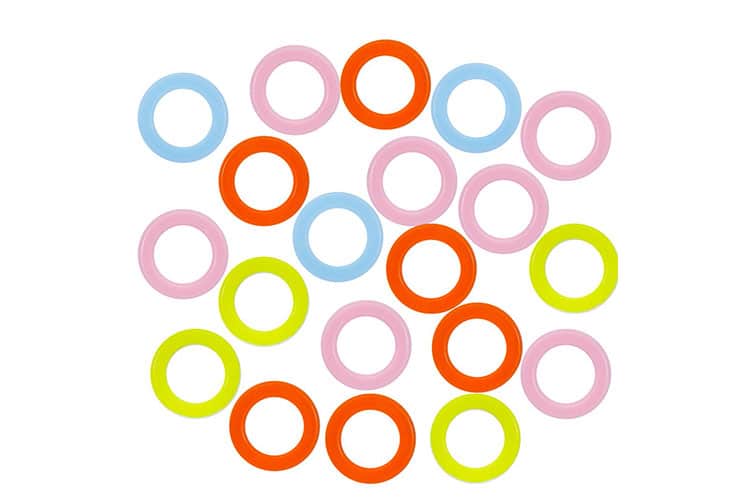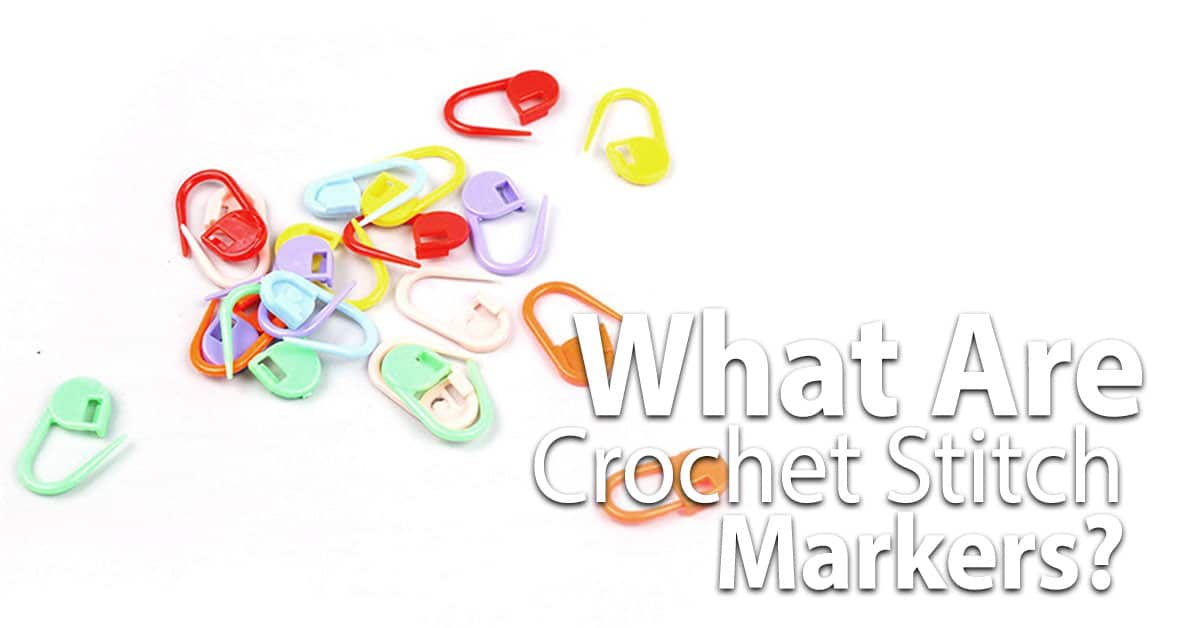If you have decided to begin crocheting, it is important to gather all the right supplies to be successful. One of the supplies you might choose to purchase are crochet stitch markers.
So what are crochet stitch markers? Crochet stitch markers are used in patterns that require a specific amount of stitches. They are a visual reference to help you count a certain number of stitches. Crochet markers are especially helpful if you tend to get frequently interrupted while crocheting or if you set a project aside and need to come back days or months later.
While not essential for every crochet project, stitch markers are considered part of the basic equipment needed for crocheting. Affordable and easy to carry, it is recommended that both beginner and experienced crocheters have a set of crochet stitch markers in their crafting kit. Without them, certain crochet projects can be very difficult to make without mistakes.
Reasons to use a crochet stitch marker

Crochet stitch markers are used for projects that require you to return to a designated point in the pattern after it has already been completed. By inserting a crochet stitch marker, you create a visual reminder of that particular location in the project so that you can easily come back later.
For example, crochet stitch markers can be used to designate changes in a certain number of stitches in a row. For example, if you make 5 of one type of stitch, place a marker, then make 5 of another type of stitch, when you approach the next row the stitch marker serves as a reminder where to change stitches again. This is helpful in projects with vertical ribbing or a border.
Crochet stitch markers can also be used to count the number of rows you have already completed (e.g. make 5 rows of one type of stitch, place a marker, then 5 rows of another stitch). This is helpful in projects with horizontal ribbing or a border.
Another use for crochet stitch markers is to mark the location where another part of the pattern is to be attached (e.g. attaching a sleeve to a sweater.) Crochet stitch markers can also be used for projects like infinity scarves or socks that are ‘worked in the round’ (see related questions for more on circular crochet.)
One final use for a crochet stitch marker is to keep your work from unraveling when you set your project aside. By placing a stitch marker in the last loop you created, there is less of a chance the project will unravel while you’re away.
Types of crochet stitch markers
When buying stitch markers, it is important to make sure you purchase the correct marker. Stitch markers come in two basic types: closed and open. As outlined below, closed stitch markers are used for knitting. Open markers are used for crochet projects. Don’t mix them up or you will run into issues with your finished project!
Open Stitch (Crochet) Markers

When purchasing crochet stitch markers, make sure you look for open or split-ring markers. As the name suggests, these markers have openings where the yarn can be easily slipped in or out of the marker. Open stitch markers can be moved or adjusted as often as needed.
A simple Google image search will reveal that crochet stitch markers come in hundreds of different shapes and materials. Markers are commonly made out of plastic or metal. They frequently come in split-ring shape (looks like a ‘q’), a safety pin shape called a locking stitch marker or shaped like a jewelry clasp. The split ring shape tends to work better for faster crocheters whereas the locking stitch markers tend to stay on a project better.
Choosing a stitch marker for crochet can also depend on the type of yarn you use. Delicate yarns or lace patterns should use lightweight stitch markers whenever possible to avoid pulling or distorting the yarn. Specialty yarns may snag easier on locking stitch markers.
There are no perfect crochet stitch markers. It is best to purchase and try several different types until you find one that fits well with your crochet technique and your current project. Even better, borrow a few from a fellow crocheter before you decide which style of open stitch marker works best for you.
Closed Stitch (Knitting) Markers

Closed stitch markers come in ring or loop shapes and are only used for knitting. There are no openings for yarn to be slipped on closed stitch markers. Instead, the markers are slipped onto a knitting needle between the stitches to be marked. The markers are then moved row to row rather than detached from the yarn.
Remember, closed stitch markers cannot be removed in the same way as open ones and should only be used in knitting. Since once a crochet row is completed the stitches are no longer ‘live’, closed stitch markers would be crocheted right into the project and only able to be removed by cutting the project (gasp!) or destroying the stitch marker.
Be sure you carefully look at the design of the marker before you purchase them or ask someone at your local craft supply store to help you find the right markers.
How to Properly Use a Crochet Stitch Marker
Crochet stitch markers are easy to use within projects. At the designated stitch or row you wish to mark, simply open the marker, securely attach it to the stitch by sliding it on the yarn or closing the stitch marker around the yarn, and continue on with the next crochet stitch. When your project is finished (or when you need to return to the marked stitch) simply re-open or slide the stitch marker off the yarn.
There are several abbreviations in standard crochet patterns that designate when you should use a stitch marker. Use crochet stitch markers whenever you see “pm” (place marker), “sm” (slip marker), or “sl m” (slip marker) listed in the pattern.
Related Questions

What does “working in the round” mean in crochet?
As noted above, one of the primary uses for crochet stitch markers is for projects ‘worked in the round.’ Working in the round is a popular method for projects like hats, socks, or rugs that involve repeating rows of stitches to form circular or tube shapes.
In projects worked in the round, at the end of the row, the first stitch is ‘joined’ to the last stitch to form a center ring. Then more rows are added like in any other crochet project. However, it is important to use a stitch marker when working in the round to designate the point at which one row ends and another row begins (where the first and last stitches were joined together). This will help ensure stitches are added evenly and for proper counting of rows if the pattern requires changing yarns.
What can I use if I do not have a stitch marker?
If you find yourself in a pinch without a crochet stitch marker or your marker has gone missing, there are several household items that can be used as a substitute.
First, many yarn crafters choose to use a small piece of yarn as a stitch marker rather than a store-bought one. This is one of the methods used by historic crocheters before plastic or metal stitch markers were readily available. Simply snip a 1-2 inch piece of yarn from a skein of yarn, thread it through the loop to be marked and tie it with a loose slip knot. When finished, either untie the yarn or snip it off the stick. Just be sure to have yarn of a contrasting color to make it stand out against your project.
Other options for homemade crochet stitch markers that work in a pinch: bread bag ties, paper clips, safety pins, dental floss, hair ties, or jewelry clasps. Cutting a plastic straw lengthwise and then into tiny sections can also work to create a set of homemade markers.
Are crochet stitch markers different than stitch counters?
When buying crochet stitch markers, you may encounter a similar product called a stitch counter. While crochet stitch markers and crochet stitch counters are both used to help keep track of special locations within stitches, they are not the same tool.
Crochet stitch markers are attached directly to the project and designate a specific stitch in the pattern. Crochet stitch counters are not typically attached to the project and are instead kept alongside or attached to your wrist as you crochet. The counter has a digital or manual tally that is ‘ticked’ ahead each time you complete a stitch or a row.
Crochet stitch counters are generally used for tracking the total number of rows completed, not individual stitches. They can be especially helpful for keeping track of large numbers of repeated rows (e.g. patterns lists a stitch for rows 1-10, then instructs you to repeat that same pattern 5 more times) or for when projects need to be left behind for long periods of time.

